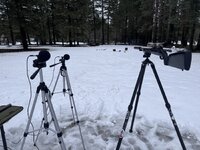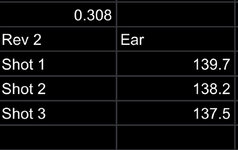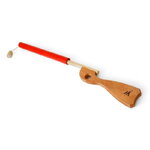JGRaider
WKR
I"m really interested in this can to put on my McWhorter 7mm08. If testing goes well, when do you anticipate them being available to order?
Follow along with the video below to see how to install our site as a web app on your home screen.
Note: This feature may not be available in some browsers.
Would love to hear results when you are ready to share.
I have to agree that the 243 WSSM and 25 WSSM were a really bad idea. The 223 WSSM had potential. It is coyote killer that could have unseated the 22-250 as predator king but for the fat case and feeding issues. I have a Winchester Model 70 in 223 WSSM that I love. It has virtually not recoil and feeds well. Fortunately, I also have over 1,000 rounds of ammo and plenty of brass. Not sure what I will do with the rifle if I ever run out!Horrible feeding characteristics and poor factory support killed the wssm cases. The 223 wssm was the only one that truly punched heavily in its caliber class. The 243wssm was just a bit faster than 243, and the 25wssm was easily beaten by the 25-06 which is what they were trying to be quantified against. Idk if 22s on magnum case heads are even necessary. The 22cm rips already, there's always the 22 middlestead which holds 10% more powder than the creed. Once you get up near 57-60gr powder in a 22, things start to get inefficient quickly. Having to go to slow burn rates in small bores starts to cause powder bridging and some really funky stuff can happen with the columns burn characteristics.
I just got back from the S2H winter course. I think six people were hammering a rock around 550 yds with 223/6.5 Creed, all suppressed with various cans.I just have a hard time believing animals are reacting differently to different suppressor "tones". All bullets will have a "crack" if they are supersonic. Does this negate a better tone from 350 yards away?
This is what I see also. I understand that Form mentioned the Scythe as one that he's not impressed with but from my experience in normal hunting scenarios, animals allow multiple kills if all hunters are shooting suppressed in the vast majority of circumstances. almost no matter the suppressor.I just got back from the S2H winter course. I think six people were hammering a rock around 550 yds with 223/6.5 Creed, all suppressed with various cans.
there were several deer within maybe 200 yards of the rock that showed ZERO reaction to any of the shooting. To top it off, we had to find another target when a muley doe decided she needed to investigate the exploding rock. She eventually walked up to 2 feet and circled it trying to wind whatever was making the rock move and make noise.
Does the "overbarrel" suppressor touch the barrel? Obviously where it is attached but down towards the chamber end? If yes how does it not affect the rifle? Cheap stocks with shit barrel channels touch when using the forend on a rest/ log, and affect shots. If not is there some sort of gasket?8” oal- 4” and 4”.
That rifle has a 16” barrel.
more cowbellMore bass.
Doesn’t touch the barrel. When you thread the barrel into the mount, the inside of the reflex stays parallel to the barrel. The only issues are that if you use an adapter it has to be smaller than the inside diameter of the OTB portion, and you damned well better Rock-set it to the barrel or you may never get the adapter out of the suppressor.Does the "overbarrel" suppressor touch the barrel? Obviously where it is attached but down towards the chamber end? If yes how does it not affect the rifle? Cheap stocks with shit barrel channels touch when using the forend on a rest/ log, and affect shots. If not is there some sort of gasket?
Much safer that way lolI don’t think you wanna be next to the target with that setup. You’d rather be the target.
No. It doesn’t.Does the "overbarrel" suppressor touch the barrel? Obviously where it is attached but down towards the chamber end? If yes how does it not affect the rifle? Cheap stocks with shit barrel channels touch when using the forend on a rest/ log, and affect shots. If not is there some sort of gasket?
Doesn’t touch the barrel. When you thread the barrel into the mount, the inside of the reflex stays parallel to the barrel. The only issues are that if you use an adapter it has to be smaller than the inside diameter of the OTB portion, and you damned well better Rock-set it to the barrel or you may never get the adapter out of the suppressor.
Thanks for the history lesson. So if it doesn’t touch the barrel how much clearance do they have and what keeps the gas from blowing back? Is there a barrel contour limit?No. It doesn’t.
This isn’t new tech. Been done in other countries for decades and AB raptor been doing here for 4-5 years.
The same way a regular supressor does. It is sealed against the end of the barrel. The otb portion is a closed system that just extends the area of the forward portion of the can.Thanks for the history lesson. So if it doesn’t touch the barrel how much clearance do they have and what keeps the gas from blowing back? Is there a barrel contour limit?
The whole point of suppressors is to redirect and slow down the gasses coming from the muzzle. The reflex is just an expansion chamber in front of your baffles. It adds to the total volume and makes your suppressor more efficient. The only downside is increased mass, but the mass is added behind the muzzle instead of in front of it.As much as I love suppressors I’ve never nerded out on how they really work. Are there any cons to forcing gas back into a narrow dead end on the reflex cans?
View attachment 845539





We did an informal sound/dB test two days ago with 4 different versions of the OTB can. These are NOT official numbers- we did not measure the distance to the shooters ear exactly, nor net it up exactly as they will when the finalized design is tested. This was just for comparative sake to see where the designs are.
Rifle was a 20” barreled 308 Winchester, using Winchester M118LR ammunition.
Setup-
View attachment 845693
The “ear” microphone was approx 36-40” left of the shooters left ear.
Where the OTB can sits currently, Average of 138 dB-
View attachment 845697
Compared to a TBAC Ultra 7 at 136dB
View attachment 845699
And a TBAC Ultra 5 at 140dB-
View attachment 845700
4 inches past the muzzle and it is within 2 Db of one of the highest regarded (by a lot of people) 7 inch suppressors on the market. 4 inches added OAL and it’s 2 dB “quieter” than probably the highest regarded 5 inch suppressor.
The goal is to get it in the 135-137 dB range and keep it in that 10’ish oz weight.
Subjective observations:
The TBAC Ultra 5 is barely a suppressor. While it meters at 140 dB it is CRACKY. The first prototype OTB can metered 142dB at the shooters ear on a 16” 223, and sounded way less obnoxious. The TBAC Ultra 7 and the OTB cans sound totally different to the shooter, to the side, and in front of the muzzle. Maybe the most descriptive way to say it is that- at the shooter and from the side, the TBAC UL7 sounds like a “PPPFFFT” with a crack to it. The OTB can sounds something like “WHOOMP” with a thud to it.
Kind of like this-
View attachment 845705
From the front, the OTB can is barely heard or noticed over the supersonic crack- the “thud” just gos unnoticed. Whereas with most cans from the front, you notice the muzzle crack at least somewhat.
